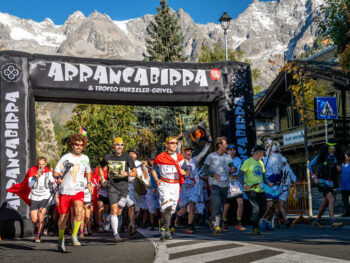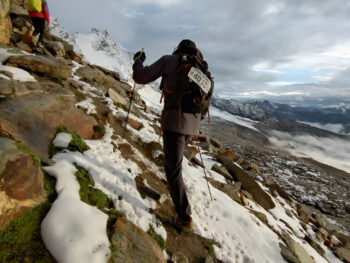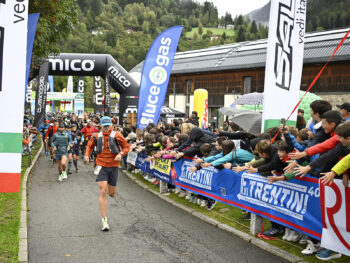The story of that tight knot in your gut that stops you in your tracks, that you just cannot explain.
The race is just a few hours away, you've been training for months. Your muscles are warm, you haven't run in days, your legs are itching to sprint, you've loaded up on carbohydrates, Vaseline on your feet, lotion on your calves, your race pack is loaded, every pouch has been carefully packed, the front loaded, your cell phone in its place, your attire carefully picked out, stacked there...
...you've been training, you've been following the nutritionist's recommended plans, and yet, you feel a strange knot in your stomach. A whole new kind of bellyache...
TORX 2022 - DAY7 - Cuney - Photo Roberto Roux | Zzam! Agency
A million niggling worries take hold; which shoes to start with, should I take a jacket with me, maybe I haven't trained hard enough, I could surely have done more and what if I drop out, what if I give a subpar performance.
You feel levels of stress and unease that up to an hour before you wouldn't even have thought existed...and that's what you call anxiety!
You have no idea just why, yet you are ravaged by a thousand uncertainties, you are confused and can't seem to find peace. You wonder why you are feeling this way, you enjoy running, no one has forced you to do it, it is the sport you have chosen... but you cannot find any peace.
You toss and turn, yet you should rest before you start, you know, you have so many hours ahead of you all on your legs.
TORX2022 - DAY5 - Gressoney - Photo Roberto Roux | Zzam! Agency
Behold anxiety knocking at your door, grabbing you by your backpack.
The notion of not being able to process those emotions, can lead to you not performing as well as you might have expected. Emotional control plays a key role in athletic performance, just as it does in everyday life.
It is imperative to understand the underlying processes and strategies to be able to train it
That feeling of being too scared
A fear of failure can hold us back and very often becomes in itself the main cause of failures. In life, as in sports, we cannot control everything as so much as we would like to, hardships, mistakes, and failures are an integral part of it, what we can work on is the impact they can have in terms of our capacity to get a handle on them and to recognize them as something that just might happen and not a total catastrophe.
Usually when we look at the lives of successful people, those who have achieved remarkable milestones, we tend not to think about how many times these people may have made mistakes before reaching these milestones. Just to give you some famous examples, think of Thomas Edison, does his name ring a bell...? You know, the inventor of the light bulb? Well, before he eventually made his luminous discovery, he made several unsuccessful attempts! When asked why he did not give up after so many failed attempts, he replied, "I have not failed. I've just found 10,000 ways that won't work."
The first step for us to take is to actually believe in ourselves, for in fact if you are the first person not to believe in you, why should others? If you can't even convince yourself that you are capable of making changes in the real world, of achieving a target, why should others do so?
TORX2022 - Ollomont, Life Base - Photo Anja Bakowska | Zzam! Agency
Now back to that pitched knot in the stomach, though.
Anxiety is a fundamental part of life; in fact, we need it, for instance, throughout our physical performance, to have adequate bodily and mental activation (arousal). It is therefore important to begin to understand that anxiety is not an evil to be gotten rid of, but rather a tool that we must learn to manage as best we can in order to give our best.
We can recognize two components of anxiety, a mind-based one (the worry and fear) that is called cognitive anxiety, which leads to experiencing a mood swing and low morale, a fear of missing out, a negative appraisal of the environment and a low self-esteem, and a somatic component, which constitutes the degree of perceived physical activation, here is that knot in the stomach, nausea, accelerated heartbeat and breathing or muscle tension.
This pattern of experiencing symptoms is circular and causes discomfort in the athlete, who will experience anxiety due to excessive preoccupation with physical symptoms, which in turn are caused by psychological ones.
Several types of anxiety are identified: situational anxiety, characterized by subjective feelings of apprehension and tension, related to changes. It is possible to experience high levels of anxiety prior to the start of the race, which subsides as one adjusts to the moment but may inevitably flare up again following a mistake that is affecting the sporting performance or outcome, such as taking a wrong turn, an unexpected annoyance. Trait anxiety, a constituent part of personality: it is an acquired behavioral tendency or predisposition. It leads us to perceive certain situations as threatening, yet they may not be so from a psychological or physical point of view.
When this happens we tend to respond with levels of anxiety that are, in intensity and magnitude, disproportionate to the objective danger and finally competition anxiety, which can manifest itself: before and during competition. Not necessarily a negative element, because this emotional reaction can help find the optimal level of activation and deliver the best possible sports performance.
Performance anxiety can depend on several personal factors such as fear of failure during competition, fear of social judgment, of being evaluated negatively, fear of injury. Another factor that predisposes to performance anxiety is perfectionism: perfectionist people often set very high standards for themselves in work, interpersonal relationships, or other areas. If these standards are not met, these people may feel inadequate, even hopeless or worthless, experiencing deep malaise.
Thus, the psychological component turns out to be crucial; in fact, according to some research, it is precisely this that has determined about 80 percent of professional victories in numerous sports. This is precisely because competition anxiety has a strong influence on an individual's motivation.
TORX2022, DAY8, Rifugio Bertone - Photo Roberto Roux | Zzam! Agency
How to manage this anxiety?
Having identified what anxiety is, let's see how to manage it... It sounds trivial, but in the meantime, to start with, breathing plays a key role. It is important to breathe correctly, breathing is a very effective tool for lowering the level of anxiety, it helps to better manage one's bodily activation. Diaphragmatic breathing, allows us to better open the lungs, allowing more oxygen to enter the blood and also allows us to relax our mind by focusing on longer and less automatic breaths.
Alongside breathing, there are useful relaxation techniques (Schultz's autogenic training, Jacobson's progressive relaxation...), which can help. These are methods by which a state of muscular and psychic decontraction is induced in the subject so that the state of anxiety can be reduced.
It is important to learn to change the inner dialogue, how we talk to each other, and it can be useful to focus on thoughts so that we can recognize and try to change those that can create an anxious and uncomfortable situation.
A practical and useful way to manage thoughts is to jot down in a diary all the thoughts experienced before and during a sports performance and analyze whether they were functional or dysfunctional, so that we can recognize and modify them more and more quickly when they arise. Turning, for example, "I can't do it," "I'll never succeed," into "I'll give my best to make it," "I'm up to it," has great consequences for our performance. Identifying what thoughts were associated with a moment of crisis in the race and what helped us get through them can be very helpful.
That said, like all emotions, it is still important to embrace them, accept them and make them a little bit our own...so acknowledged that knot, embraced the emotions and what we were feeling we laced up our cleats, one last check and off to the starting line...
© 2009-2024 by VDA Trailers SSDrl
Any dissemination for commercial purposes of photographic or video images captured during the event, via any means (internet, social networks, TV, press, magazines, etc.), without written authorisation from the organisation is prohibited. GTC®, GTC100™, GTC55™, GTC30™, TORX®, TOR®, Tor des Géants®, Tor des Glaciers™, Passage au Malatrà™, Tot Dret™, TOR450™, TOR330™, TOR130™, TOR100™ and TOR30™ are trademarks owned or used exclusively by VDA Trailers. Any communication of the event or use of images of it must be done in observance of the name of the event and registered trademarks, subject to agreement by the organisation.
Valle d’Aosta Trailers SSDrl | Via Roma, 98 | 11013 Courmayeur | CF/P.IVA 01139360075 | Nr. Iscr. Reg. Imprese AOSTA AO-70629




